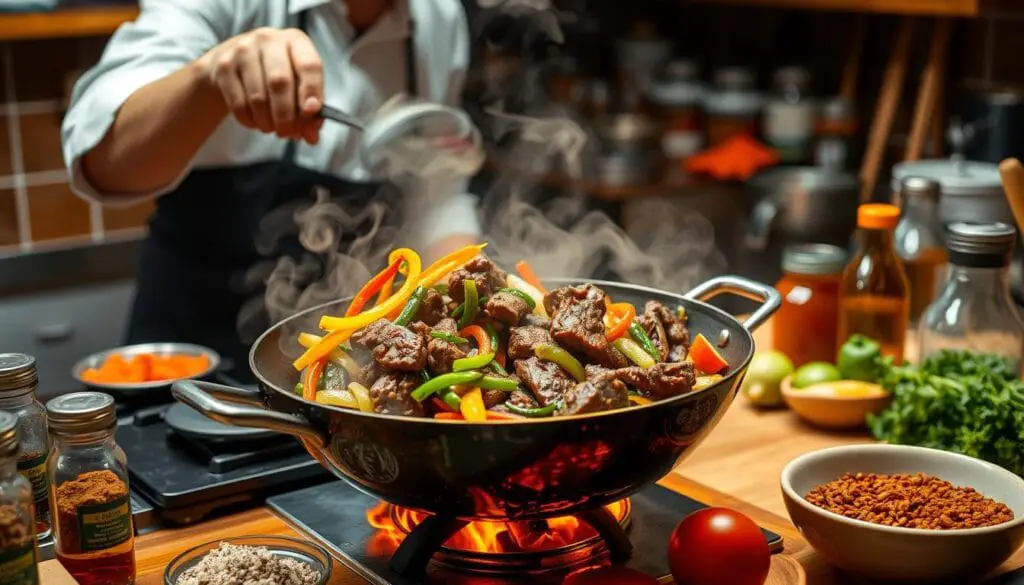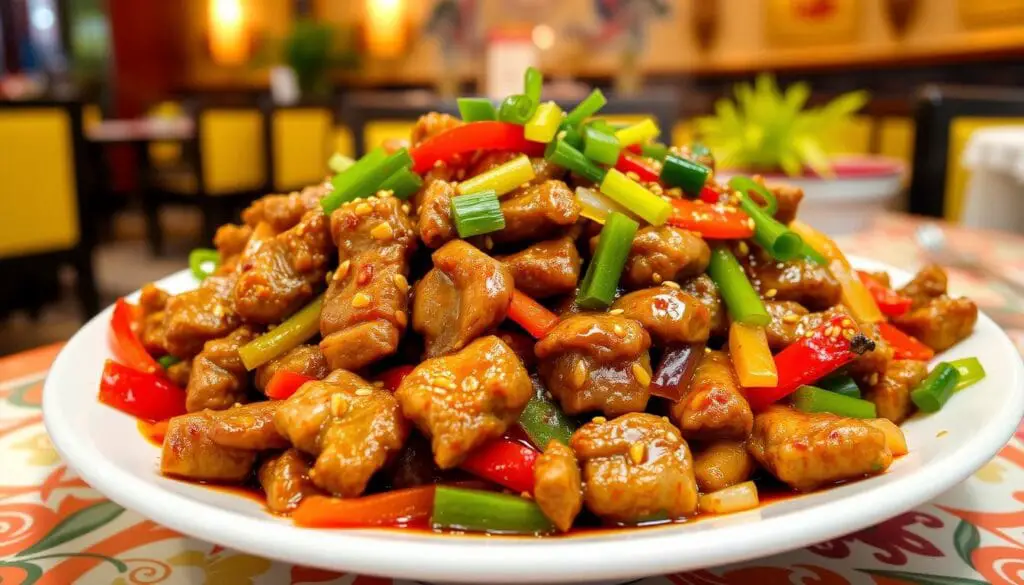Step-by-Step Guide to Making Beijing Beef Panda Style
I love cooking at home and exploring Chinese flavors. Beijing beef from Panda Express is a favorite of mine. It’s crispy beef, fresh veggies, and a sauce that’s both sweet and savory. It’s like a taste of China in every bite.
If you also love Beijing beef, I have a guide for you. You can make this Panda Express favorite at home. Impress your loved ones with your cooking skills as we learn to make Beijing beef Panda style.
Table of Contents
Understanding Beijing Beef’s Culinary Heritage
Beijing beef is a favorite in the Beijing culinary scene. It combines traditional Chinese cooking with modern American tastes. This dish, known for its savory and slightly sweet flavor, started in the capital city. It’s now a key dish in both local eateries and big Chinese-American chains.
Origins and Evolution of the Dish
The history of Beijing beef goes back to traditional Chinese stir-fries. These stir-fries mix tender beef with a tasty sauce and crisp veggies. American-Chinese places like Panda Express later added their twist, making it more appealing to Western tastes.
Key Flavor Profiles and Characteristics
The taste of Beijing beef is special. It’s a mix of sweet, savory, and a bit spicy. The sauce, made with soy sauce, brown sugar, and chili garlic sauce, adds depth. The beef is tender, and it’s often served with crunchy bell peppers and green onions for a nice crunch.
Traditional vs. Modern Preparation Methods
Traditionally, Beijing beef is cooked in a wok with careful marinades. This makes the meat tender and full of flavor. But, in modern American-Chinese cooking, it’s sometimes made faster. Restaurants might use the “velveting” method to get a similar texture.
“Beijing beef is a beloved staple in the city’s culinary landscape, blending the best of Chinese and American-Chinese flavors.”
Essential Ingredients for Beijing Beef Panda
To make authentic Beijing beef, you need top-notch ingredients. The main protein is usually flank steak or sirloin, cut into thin slices. This makes the meat tender and juicy.
The beef is marinated in a mix of egg whites, cornstarch, and salt. This step helps keep the meat moist and flavorful.
The sauce is the heart of the dish. It’s a mix of soy sauce, rice vinegar, brown sugar, and more. These ingredients blend together to create a sweet and savory sauce that goes perfectly with the beef.
Onions and bell peppers add color, crunch, and flavor to the dish. Choosing locally and organically grown ingredients supports the sustainable meat and farm-to-table movement.
| Ingredient | Quantity |
|---|---|
| Flank steak or sirloin | 1 ¾ lb (800 g) |
| Egg whites | 3 |
| Salt | ½ teaspoon |
| Cornstarch | 1 teaspoon |
| Sauce water | ½ cup (114 g) |
| Low-sodium soy sauce | ¼ cup (67 g) |
| Honey | ¼ cup (63 g) |
| Low-sugar ketchup | 3 tablespoons (51 g) |
| Apple cider vinegar | 2 tablespoons (28 g) |
| Peanut butter | 1 tablespoon (16 g) |
| Garlic powder | ½ teaspoon |
| Crushed red peppers | ¾ teaspoon |
| Red bell pepper | 1 |
| Onion | 1 |
| Garlic cloves | 4 |
| Cooked rice | 3 cups (550 g) |
With these ingredients, you’re ready to make a delicious Beijing beef dish. It’s a great way to enjoy sustainable meat and support the farm-to-table movement. Now, let’s start cooking!
Preparing the Perfect Beef Marinade
Creating the ultimate beef dishes starts with a great marinade. For the perfect Beijing Beef Panda, picking the right beef is key.
Selecting and Slicing the Right Cut of Beef
Flank steak or sirloin are the best choices. Slice the beef thinly, against the grain, for tenderness. Thin slices soak up marinade flavors well.
Marinade Components and Timing
The marinade mixes savory and aromatic ingredients. It includes soy sauce, sesame oil, garlic powder, and cornstarch. Marinate for 30 minutes to 2 hours for the best flavor and tenderness.
Tips for Maximum Flavor Absorption
- Evenly coat the beef slices with the marinade, ensuring each piece is well-covered.
- Refrigerate the marinating beef to maintain the ideal temperature and prevent bacterial growth.
- Avoid over-marinating, as prolonged exposure to the acidic ingredients can make the beef mushy.
By following these steps, you’ll unlock the key to creating the perfect eco-friendly dining experience with your Beijing Beef Panda dish.
Crafting the Signature Beijing Beef Sauce
The heart of Beijing beef is its sauce. This sauce is a mix of Asian flavors, creating a unique taste. To make the sauce, you need to mix different ingredients together.
Start by mixing rice vinegar, brown sugar, hoisin sauce, tomato paste, oyster sauce, and plum sauce in a bowl. These ingredients give the sauce its tangy, sweet, and savory taste. Then, add soy sauce for more depth, and onion and garlic powder for a spicy aroma.
Finally, add minced fresh ginger to the sauce. This adds a spicy warmth, making the sauce more complex. Whisk everything together until it’s well mixed.
The secret to great Beijing beef sauce is finding the right balance. You can adjust the ingredients to your liking, staying true to chinese cuisine and beijing culinary scene. The sauce should be sweet, sour, and slightly spicy.
Now that you have the sauce, you’re ready to make a dish that truly represents chinese cuisine and the beijing culinary scene. Get ready to enjoy the bold flavors of Beijing beef.
Mastering the Stir-Frying Technique
The secret to perfect Chinese cuisine and beef dishes is stir-frying. This method cooks ingredients quickly, keeping them tender and full of flavor. It also creates a tasty caramelized crust. Here are some key tips to master stir-frying:
Proper Heat Management
Stir-frying needs high heat to sear and keep juices in. Heat your wok or skillet to high before adding oil. When the oil starts shimmering, it’s time to add your ingredients.
Wok Handling Essentials
A seasoned wok is crucial for stir-frying. Hold the wok handle firmly and move it in circles to toss the ingredients. This helps cook everything evenly and prevents burning.
Timing and Sequence Tips
- Stir-fry beef in small batches for even browning and to avoid overcrowding.
- Take the beef out and set it aside before cooking the vegetables.
- Finally, mix all ingredients with the sauce. Cook until the sauce thickens and coats everything.
With these stir-frying techniques, you can make delicious Chinese cuisine and beef dishes. They will surely impress your taste buds.

Vegetable Selection and Preparation
Choosing the right vegetables is key to making a great Beijing beef dish. You can use onions and bell peppers, but also add fresh, local produce. This makes the dish taste better and is good for you. It also supports the farm-to-table movement and eco-friendly dining.
Begin by cutting the onions and bell peppers into small pieces. Add broccoli, snap peas, or mushrooms for extra crunch and color. Make sure all veggies are the same size so they cook evenly.
| Vegetable | Calories | Protein (g) | Sugar (g) |
|---|---|---|---|
| Broccoli | 55 | 2.6 | 1.7 |
| Snap Peas | 26 | 1.9 | 2.8 |
| Mushrooms | 15 | 2.2 | 1.1 |
| Bell Peppers | 31 | 1.2 | 3.1 |
| Onions | 44 | 1.1 | 4.7 |
Using a variety of fresh, local veggies makes your Beijing beef dish look and taste amazing. It also supports the farm-to-table movement and eco-friendly dining. These trends are popular among people who care about their health.
Achieving the Perfect Crispy Texture
To make the classic Beijing beef dish even better, getting the crispy texture right is key. The secret is the double-frying method. This technique makes your beef tender yet crunchy.
Double-Frying Method
The first part of double-frying is frying the beef at a lower temperature, about 325°F (165°C). This step keeps the beef tender and juicy. Then, fry it again at a higher temperature, around 375°F (190°C), for a crispy outside.
It’s important to keep the oil at the right temperature. Use a cooking thermometer to check the oil and adjust it if needed. Fry the beef in batches to avoid overcrowding, which can ruin the crispiness.
Temperature Control Techniques
- Start with the oil at the lower temperature of 325°F (165°C) to cook the beef through.
- Once the beef is cooked, increase the oil temperature to 375°F (190°C) for the final frying.
- Allow the excess oil to drain on paper towels between the two frying steps to ensure maximum crispiness.
- Adjust the heat as needed to maintain the optimal temperatures for each frying stage.
Mastering the double-frying method and controlling the temperature will give you the perfect crispy texture. This makes the Beijing beef panda stand out among other beef dishes. You’ll get a tender inside and a golden-brown outside that’s just delicious.

Plating and Serving Suggestions
Make your Beijing beef stand out with great plating and serving. Serve the beef hot, right after cooking. This highlights its crispy texture and delicious taste. For a classic look, place the Beijing beef on fluffy white rice or fragrant fried rice.
For a pop of color and extra taste, top it with sliced scallions or toasted sesame seeds. If you prefer less carbs, try cauliflower rice. Pair it with steamed dumplings or a light soup for a full meal.
Use eco-friendly plates and utensils to make your meal more sustainable. This choice is good for the planet and fits with the trend of eco-friendly Beijing restaurants.
“The true beauty of Beijing beef lies in the harmony of its flavors and the care with which it is presented.” – Chef Mei Lian, renowned Beijing restaurants expert
Focus on the details of plating and serving to make your Beijing beef dish special. It will look great and taste amazing. Show off Beijing‘s rich food culture and your commitment to eco-friendly dining with every bite.
Conclusion
Making Beijing Beef at home is a great way to enjoy authentic Chinese-American food. It lets you make the dish just how you like it. With this guide, you can make a tasty version of takeout using good ingredients and improving your cooking.
You can try new veggies or use different proteins in this recipe. It’s a great base for any diet. Making Beijing Beef is a fun way to learn about Chinese food and help pandas too.
Enjoying Beijing Beef is a treat for your taste buds and a sign of your cooking growth. It’s a journey of discovering new flavors and cultures. So, enjoy your meal and look forward to more tasty adventures in Chinese cuisine!







